Crux, or the Southern Cross, is a prominent constellation in the southern sky. It is the smallest of all 88 constellations.
In spite of its size, Crux is one of the best known constellations in the southern hemisphere. It is easily recognizable for the cross-shaped asterism, the Southern Cross, formed by its five brightest stars. The constellation is associated with a number of stories and it figures prominently in different mythologies in the southern hemisphere. It holds special importance in Australia and New Zealand, where it is circumpolar and can be seen throughout the year.
Crux is not visible north of +20° in the northern hemisphere, and it is circumpolar south of 34°S, which means that it never sets below the horizon. On the celestial sphere, Crux is exactly opposite the constellation Cassiopeia.
Crux means “the cross” in Latin. Ancient Greeks considered Crux to be a part of the constellation Centaurus. Even though its stars were charted on most celestial globes, it was not until 1679 that it became a constellation in its own right. It was the French astronomer Augustin Royer who formally separated Crux from Centaurus. Some historians credit the Dutch astronomer Petrus Plancius for creating the constellation in 1613, as it was published by Jakob Bartsch in 1624.
Facts, location and map
Crux is the smallest of the 88 constellations, occupying an area of only 68 square degrees. It is located in the third quadrant of the southern hemisphere (SQ3) and can be seen at latitudes between +20° and -90°. The neighboring constellations are Centaurus and Musca.
The constellation name Crux is pronounced /ˈkrʌks/. In English, the constellation is known as the Southern Cross. The genitive form of Crux, used in star names, is Crucis (pronunciation: /ˈkruːsɪs/). The three-letter abbreviation, adopted by the International Astronomical Union (IAU) in 1922, is Cru.
Crux belongs to the Hercules family of constellations, along with Aquila, Ara, Centaurus, Corona Australis, Corvus, Crater, Cygnus, Hercules, Hydra, Lupus, Lyra, Ophiuchus, Sagitta, Scutum, Sextans, Serpens, Triangulum Australe, and Vulpecula.
Crux has one star with known planets and contains no Messier objects. The brightest star in the constellation is Acrux, Alpha Crucis, with an apparent magnitude of 0.77. Acrux is also the 12th brightest star in the sky. There is one meteor shower associated with the constellation; the Crucids.
Crux contains six named stars. The proper names of stars that have been officially approved by the International Astronomical Union (IAU) are Acrux, Gacrux, Ginan, Imai, Mimosa, and Tupã.
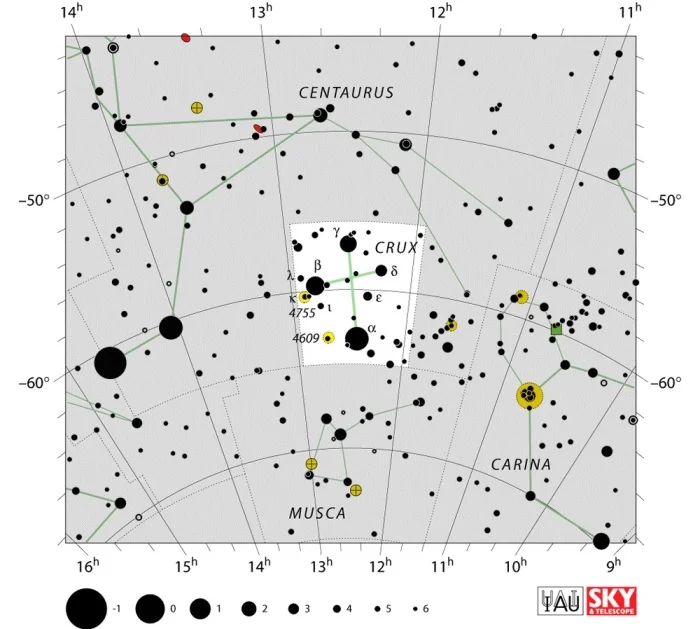
Crux constellation map by IAU and Sky&Telescope magazine
Mythology
Crux is a famous constellation in many cultures. Ancient Greeks considered it to be part of the Centaurus constellation. Greeks were able to see Crux before its stars dropped below the horizon for Europe and most of the northern hemisphere. Some saw significance in this, linking the disappearance of the celestial cross from the sky to the crucifixion of Christ. The 2nd century Greek astronomer Ptolemy listed the stars of Crux as part of the constellation Centaurus in his Almagest. By the year 400 AD, the constellation was not visible from most of Europe anymore, and Europeans did not rediscover Crux until the great naval expeditions of the late 15th and early 16th century.
The Southern Cross carries cultural significance in many countries in the southern hemisphere.
A stone image of Crux constellation has been found in Machu Picchu in Peru. The Inca knew the constellation as Chakana, which means “the stair.” The Maori called it Te Punga, or “the anchor.”
In Australian Aboriginal astronomy, the cross asterism and the Coalsack Nebula represent the head of the Emu in the Sky. The Southern Cross is represented on the Australian flag. Its stars are also featured on the flag of Brazil, where the asterism is known as Cruzeiro, or Cruzeiro do Sul. The Southern Cross is also mentioned in the Brazilian national anthem and used to be the name of the currency between 1942 and 1986 and again between 1990 and 1994.
Amerigo Vespucci charted the stars in 1501, but a more accurate depiction appeared in 1515, made by another Italian explorer, Andrea Corsali. Crux appeared on celestial globes by Petrus Plancius (1598) and Jodocus Hondius (1600). Plancius, a Dutch cartographer, depicted the constellation based on observations by Pieter Dirkszoon, a Dutch explorer.
Crux stars
Acrux – α Crucis (Alpha Crucis)
Acrux, Alpha Crucis, is the brightest star in the constellation and the 12th brightest star in the sky. The star has an apparent magnitude of 0.77 and is approximately 320 light years distant. Its name is short for Alpha Crux. At -63° declination, Alpha Crucis is the southernmost first magnitude star. It cannot be seen north of latitude 27°N.
Acrux is a multiple star system composed of Alpha-1 Crucis, a B class subgiant, and Alpha-2 Crucis, a B class dwarf. The two are separated by four arc seconds. Both stars are very hot, almost class O, and their respective luminosities are 25,000 and 16,000 times that of the Sun.
Alpha-1 Crucis is a spectroscopic double, with 14th and 10th magnitude components orbiting each other with a period of 76 days. There is another B class subgiant star in the system, but it is believed to be more distant from the other components and merely located along the same line of sight.
Acrux has cultural significance in the southern hemisphere. It is found on the flags of several countries – Australia, Papua New Guinea, New Zealand – along with the other four stars of the Southern Cross. It is also one of the 27 stars representing different states on the flag of Brazil. Alpha Crucis represents the State of São Paulo.
Mimosa (Becrux) – β Crucis (Beta Crucis)
Beta Crucis is the second brightest star of the Southern Cross and the 20th brightest star in the night sky. It has an apparent magnitude of 1.30 and is approximately 350 light years distant from the solar system. It is classified as a Beta Cephei variable. The star can only be seen from locations south of the Tropic of Cancer (23° 26′ 16″ N). Its estimated age is 10 million years.
Beta Crucis is a spectroscopic binary composed of two stars, about 8 AU apart, that orbit each other every five years. Becrux belongs to the spectral type B0.5IV and is thought to be the hottest first magnitude star. It got the name Mimosa because of its colour. The star represents the State of Rio de Janeiro on the flag of Brazil.
Gacrux – γ Crucis (Gamma Crucis)
Gamma Crucis, or Gacrux, is a red giant belonging to the spectral class M4III. It has an apparent magnitude of 1.59 and is approximately 88 light years distant from Earth.
Gamma Crucis is the third brightest star in Crux and the 26th brightest star in the sky. It is a binary star, with a primary component belonging to the spectral class M4 III and a white, A3 class star with a visual magnitude of 6.4 for an optical companion. The companion is about 400 light years distant from Earth.
Imai – δ Crucis (Delta Crucis)
Delta Crucis is a subgiant of the spectral type B2IV. It has an apparent magnitude of 2.775 and is about 360 light years distant. It is classified as a Beta Cephei type variable.
ζ Crucis (Zeta Crucis)
Zeta Crucis is another double star in Crux constellation. It is composed of a blue-white dwarf belonging to the spectral class B2.5 V, and a faint (12.49m) companion.
Zeta Crucis has an apparent magnitude of 4.04 and is approximately 360 light years distant.
Ginan – ε Crucis (Epsilon Crucis)
Epsilon Crucis is an orange giant, a class K3III star with a visual magnitude of 3.56, approximately 228 light years distant from Earth. The star is also represented on the flag of Brazil: it represents the State of Espírito Santo.
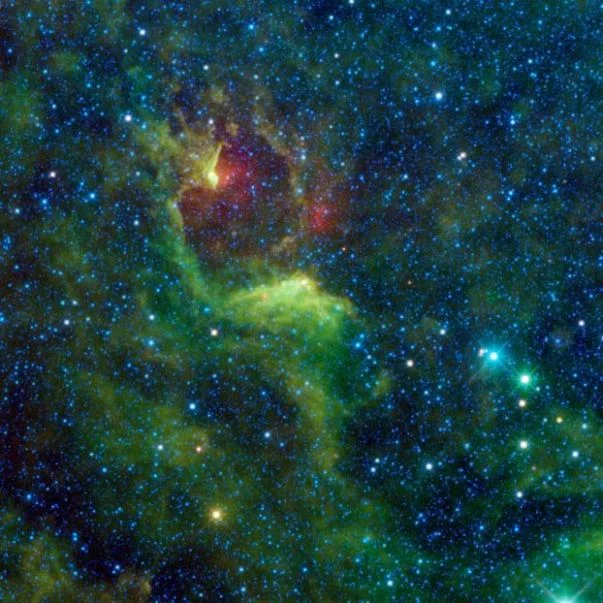
Epsilon Crucis and the reflection nebula IRAS 12116-6001, image: NASA, JPL-Caltech, WISE Team
θ Crucis (Theta Crucis)
Theta Crucis is a designation shared by two distinct star systems. Theta-1 Crucis is a spectroscopic double belonging to the spectral class Am, approximately 230 light years distant. It has a visual magnitude of 4.30.
Theta-2 Crucis is also a spectroscopic binary star, composed of a pair of stars that orbit each other with a period of 3.4280 days. The star system has a stellar classification of B2 IV. It is about 750 light years distant from the solar system and has an apparent magnitude of 4.72. One of the stars is a Beta Cephei variable and its luminosity varies between 4.70 and 4.74.
λ Crucis (Lambda Crucis)
Lambda Crucis is a blue-white dwarf with an apparent magnitude of 4.6. It is about 360 light years away from the solar system. Its spectral classification is B4Vne, and the star is also classified as a Beta Cephei variable, the type of variable star that exhibits change in brightness as a result of the pulsation of its surface. The star’s luminosity varies by 0.02 magnitudes over a period of 0.3951 days.
ι Crucis (Iota Crucis)
Iota Crucis is an orange giant, belonging to the spectral class K0 III, approximately 125 light years distant. It has a visual magnitude of 4.69. The star has an optical companion, a class G8 star with a magnitude of 10.8.
BZ Crucis
BZ Crucis is a Be star classified as a B1IVe class star, a B class subgiant showing emission lines in its spectrum. It is a Gamma Cassiopeiae type variable star, which is to say a shell star that has a circumstellar gas disk around the equator. BZ Crucis is an X-ray source. It has an apparent magnitude of 5.316 and is approximately 1,000 light years distant. It is located behind the Coalsack Nebula.
NGC 4349-127
NGC 4349-127 is a red giant star almost 20 times as massive as Jupiter. It is 7,097 light years distant. It has an apparent magnitude of 7.4 and an absolute magnitude of -4.3. A companion star, believed to be a brown dwarf, was discovered in 2007.
Deep sky objects in Crux
Coalsack Nebula (Caldwell 99)
The Coalsack Nebula is a famous dark nebula, easily seen as a large dark patch in the southern region of the Milky Way. It stretches across nearly seven by five degrees of the sky, crossing over into the neighbouring constellations, Centaurus and Musca. It is between 30 and 35 light years in radius. The nebula is about 600 light years distant from Earth.
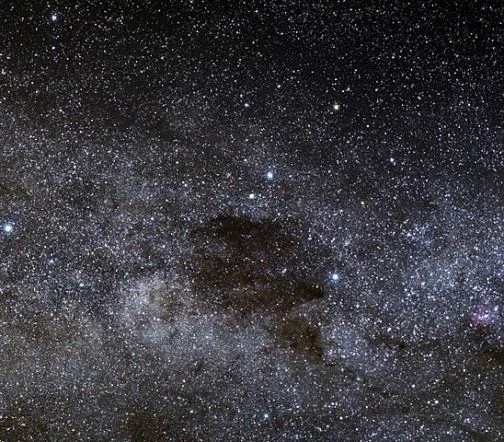
The Coalsack is one of the most prominent dark nebulae visible to the unaided eye. A beautiful sight in the southern sky, the Coalsack casts a dark silhouette against the Milky Way’s bright stripe of stars. The Coalsack is located approximately 600 light-years away from Earth in the southern part of the constellation of Crux (the Southern Cross). This seemingly starless dark patch is actually an opaque interstellar dust cloud that obscures the light of the background Milky Way stars. Dust grains in the cloud redden the starlight that reaches us by absorbing blue light preferentially, so that the red stars shimmering in the northern and darkest part of the Coalsack appear more crimson than they would in the absence of this dust. The first European to see this remarkable object was probably the Spanish navigator and explorer Vincente Yanez Pinzon when he sailed to the South American coast in 1499. The Coalsack earned the nickname “Black Magellanic Cloud” in the 16th century, apparently rivalling the prominence of the Large and Small Magellanic Clouds, the two dwarf irregular galaxies that shine brightly in the skies of the Southern Hemisphere. The Incas tell that the god Ataguchu, in a fit of temper, kicked the Milky Way and a fragment flew off, forming the Small Magellanic Cloud where it landed on the sky, and leaving the black mark of the Coalsack behind. Beware of Inca gods in a bad mood! Another famous sight seen from southern latitudes — though it can creep into view in tropical northern latitudes — is the Southern Cross, or Crux. This cross-shaped constellation has assumed great significance in the cultures of the Southern Hemisphere, even as far back as prehistoric times. So distinctive and evocative is the Southern Cross that the national flags of Australia, Brazil, New Zealand, Papua New Guinea, and Samoa all include a representation of it. The European Southern Observatory (ESO) has also acknowledged the significance of Crux as the foremost constellation of the southern skies, and has proudly incorporated the cross-shaped symbol into the ESO logo. Image: ESO/S. Brunier
As a result of its size, the Coalsack Nebula was known in pre-historic times in the southern hemisphere. It was observed by the Spanish navigator and conquistador Vicente Yáñez Pinzón in 1499. Amerigo Vespucci named it il Canopo fosco, which means “the dark Canopus.”
In Aboriginal astronomy in Australia, the nebula represents the head of the Emu, the bird associated with several local creation myths.
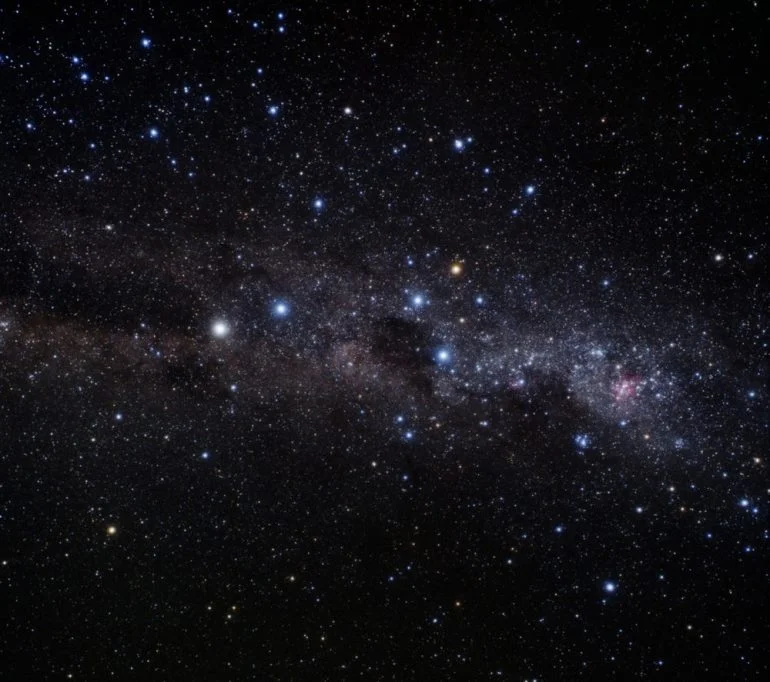
The Coalsack Nebula and the Jewel Box (Kappa Crucis Cluster), image: A. Fujii — The Jewel Box is shown just right of center, above the dark nebula called the Coalsack in this picture of the southern sky. The picture was taken with a small ground-based camera.
Jewel Box Cluster (Kappa Crucis Cluster, NGC 4755)
The Kappa Crucis Cluster, also known as the Jewel Box (or Herschel’s Jewel Box), is an open star cluster in Crux. It is one of the youngest clusters ever discovered, with an estimated age of only 14 million years.
The cluster has a visual magnitude of 4.2 and contains about a hundred stars. It is approximately 6,440 light years distant from the solar system.
The cluster can only be observed from the southern hemisphere. It was discovered by the French astronomer Nicolas Louis de Lacaille on his trip to South Africa in 1751-52.
19th century English astronomer Sir John Herschel described the cluster as “a casket of variously coloured precious stones,” which is how the cluster appears in a telescope and how it subsequently got the name the Jewel Box.
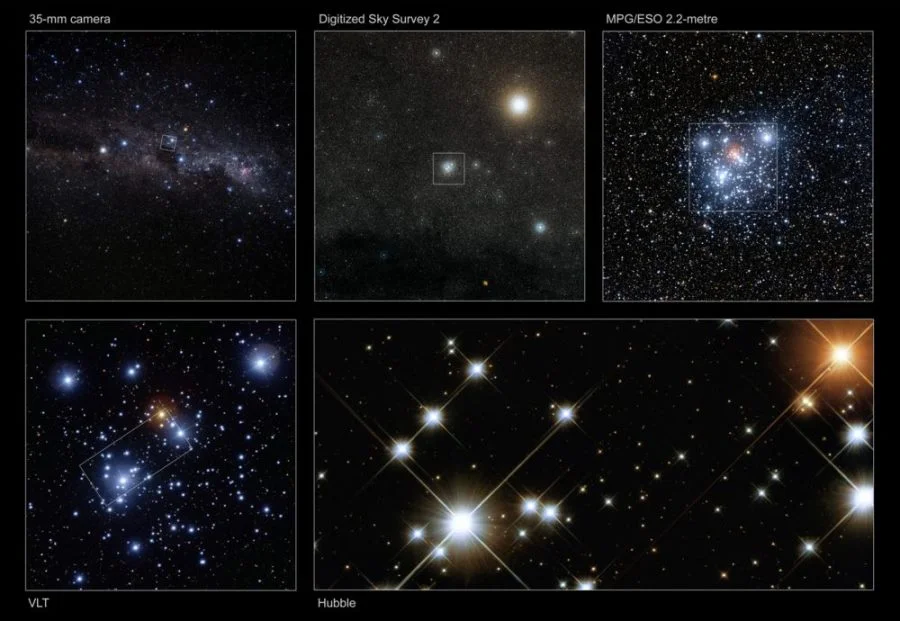
This composite image serves as a still “zoom-in”, showing the rich star field in which NGC 4755 nestles and then moving in to the detailed Hubble image of the Kappa Crucis Cluster, or Jewel Box, itself. The range of images begins with a very wide-field view of the sky surrounding NGC 4755. The images then progressively “zoom in” to reveal a “close-up” of the Jewel Box, featuring several very bright, pale blue super-giant stars, a solitary ruby-red super-giant and a variety of other brilliantly coloured stars. Image: ESO, NASA/ESA, Digitized Sky Survey 2 and Jesús Maíz Apellániz (Instituto de Astrofísica de Andalucía, Spain)
To the unaided eye, the cluster appears like a star near Beta Crucis, one of the stars that form the Southern Cross.
The brightest stars in the Jewel Box Cluster are supergiants. The three brightest stars got the nickname “traffic lights” because of their different colours.
The dominant star in the cluster is Kappa Crucis (HD 111973), a red, M-type supergiant with a visual magnitude of 5.98. The star stands in stark contrast with other stars in the cluster, which are mostly blue.
Kappa Crucis is approximately 1,700 light years distant. It has an absolute magnitude of -6.0.
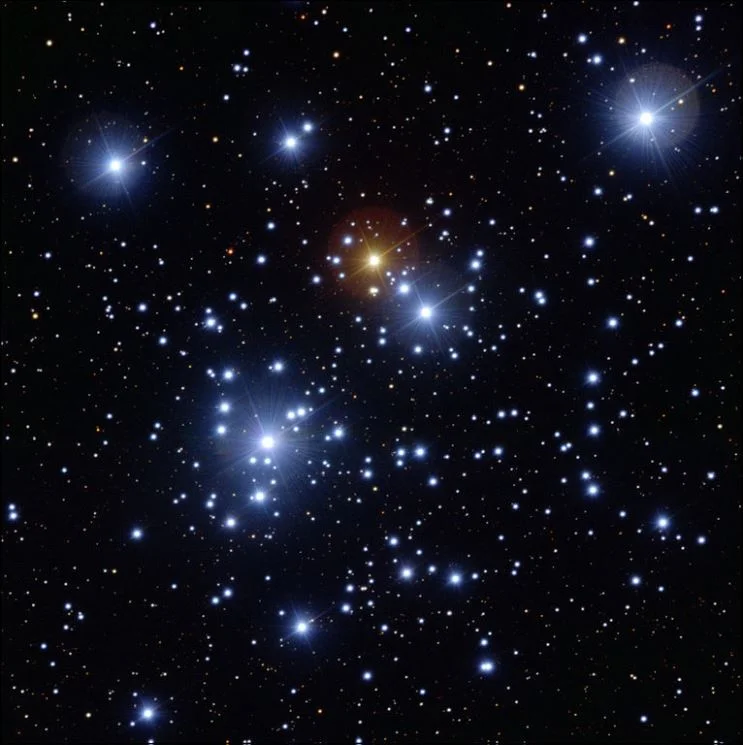
The FORS1 instrument on the ESO Very Large Telescope (VLT) at ESO’s Paranal Observatory was used to take this exquisitely sharp close up view of the colourful Jewel Box cluster, NGC 4755. The telescope’s huge mirror allowed very short exposure times: just 2.6 seconds through a blue filter (B), 1.3 seconds through a yellow/green filter (V) and 1.3 seconds through a red filter (R). Image: ESO/Y. Beletsky